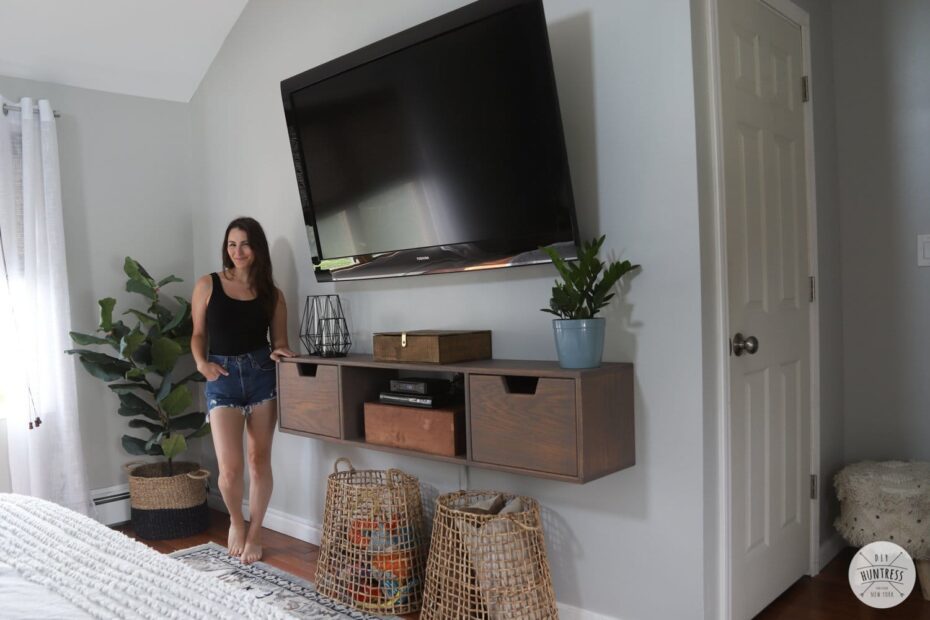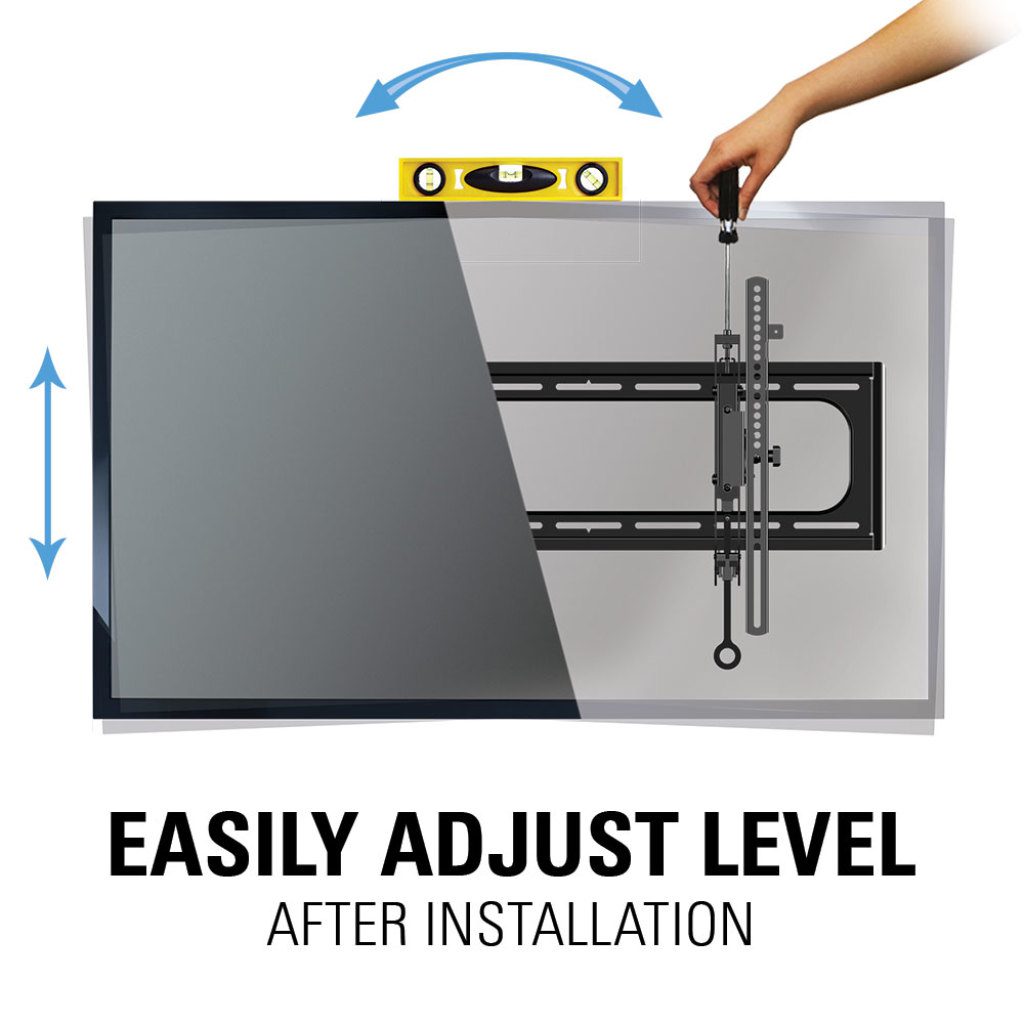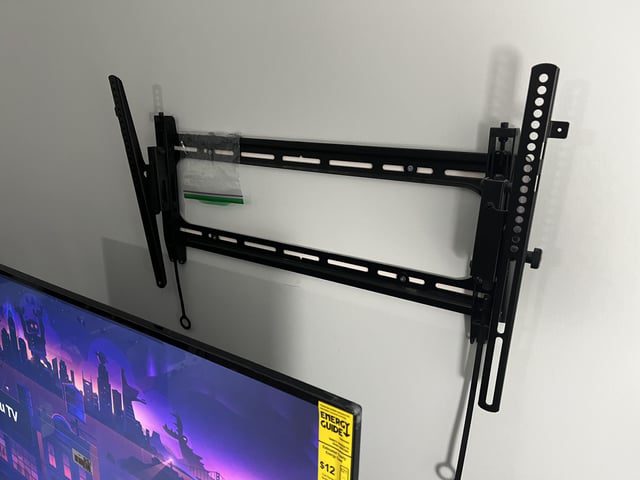To mount a floating TV stand, start by measuring and marking the wall for the desired height and position of the stand. Then, install the wall bracket securely using a drill and screws.
Finally, attach the floating TV stand to the bracket, ensuring it is level and secure.
Choosing The Right Floating Tv Stand
When it comes to mounting a floating TV stand, one of the most important factors to consider is choosing the right stand for your space. A floating TV stand not only adds a sleek and modern touch to your living room but also provides a space-saving solution, keeping the floor clean and clutter-free. To ensure you make the best choice, there are several key considerations to keep in mind.
Considerations For Selecting A Floating Tv Stand
Before diving into the selection process, it’s crucial to assess your needs and preferences. Take the time to think about the following factors:
- TV Size: Measure your TV’s dimensions and select a floating TV stand that can comfortably accommodate it. Ensure that the stand provides enough support and stability for your specific TV size.
- Weight Capacity: Check the weight capacity of the floating TV stand to ensure it can handle the weight of your TV. It’s important to consider both the weight of the TV itself and any additional equipment, such as soundbars or gaming consoles, that you plan to place on the stand.
- Style and Aesthetics: Consider the overall style and aesthetics of your living room or entertainment area. Look for a floating TV stand that complements your existing decor and enhances the visual appeal of the space.
- Storage and Shelving: Determine whether you need additional storage space for your media devices, DVDs, or cable boxes. Some floating TV stands come with built-in shelves or cabinets, providing convenient storage options.
- Material and Durability: Assess the material and construction of the floating TV stand to ensure it offers durability and long-lasting performance. Common materials include wood, metal, and tempered glass, each with its own unique benefits.
- Installation and Mounting: Take into account the ease of installation and mounting options offered by the floating TV stand. Check if it comes with a mounting kit and detailed instructions to help you seamlessly install it in your desired location.
Measuring And Assessing Your Space
Before making a final decision, it’s crucial to measure and assess your space properly. Follow these simple steps to ensure a perfect fit:
- Measure Wall Space: Measure the available wall space where you intend to mount the floating TV stand. Consider the height and width, ensuring there is enough room for the stand without interfering with other furniture or decor.
- Height Placement: Decide on the ideal height placement for your TV stand. Consider eye-level viewing comfort and make sure the stand is positioned at a height that suits your seating arrangement.
- Access to Cables: Check for easy access to power outlets and cable connections in the chosen location. It’s essential to have easy cable management and ensure that the floating TV stand doesn’t obstruct any necessary connections.
- Clearance for Ventilation: Make sure to leave ample space around the TV for proper ventilation. It’s crucial to prevent the TV from overheating, so ensure there is enough clearance on all sides.
By carefully considering these factors and thoroughly measuring your space, you’ll be equipped with the knowledge needed to choose the perfect floating TV stand for your needs. So go ahead and enhance your living room with a stylish and space-saving solution!

Credit: m.youtube.com
Preparing Your Wall
To mount a floating TV stand, first, prepare your wall by locating wall studs for secure installation. Measure and mark the desired height and use a level to ensure the stand is straight. Finally, use appropriate hardware and tools to mount the stand, following the manufacturer’s instructions.
Preparing Your Wall Mounting a floating TV stand can instantly elevate the aesthetics of your living space while freeing up valuable floor space. Before you dive into the installation process, it’s crucial to prepare your wall properly. This involves finding the right wall studs and marking the wall accurately. Let’s explore each step further. Finding the Right Wall Studs Locating the wall studs is essential to ensure the stability and security of your floating TV stand. Wall studs are sturdy vertical beams behind the drywall that provide the necessary support for the weight of the stand and your television. To find the studs, follow these simple steps: 1. Grab a stud finder tool, available at any hardware store. Place it against the wall and move it slowly in a horizontal motion, following the manufacturer’s instructions. 2. Once the tool detects a stud, it will indicate it with a light or sound. Remember, studs are typically spaced 16 or 24 inches apart, so continue scanning the wall to locate additional studs. Marking and Leveling the Wall Once you’ve identified the wall studs, it’s time to mark and level the wall to ensure accurate installation. Here’s how you can do it properly: 1. Using a pencil, lightly mark the location of each stud you found. Make sure the marks are visible and easily distinguishable. 2. Using a measuring tape, determine the desired height for your floating TV stand. Remember to consider the eye level and the size of your television for optimal viewing experience. 3. With a level, draw a horizontal line across the wall at the desired height. This line will serve as a guide for mounting the stand accurately. By preparing your wall correctly, you’re setting a solid foundation for a successful installation of your floating TV stand. With the wall studs located and marked, and the wall leveled, you’re ready to proceed with mounting your stand securely and effortlessly. Remember to refer to the manufacturer’s instructions for the specific installation process.Mounting The Floating Tv Stand
Mounting a floating TV stand not only adds a modern touch to your living space but also saves valuable floor space. With a sleek design and the appearance of the TV stand floating on the wall, it can enhance the aesthetic of any room. In this section, we will guide you through the process of mounting your floating TV stand, step by step.
Attaching The Mounting Bracket To The Wall
Before you can secure your floating TV stand, you need to attach a mounting bracket to the wall. Here’s how to do it:
- Start by choosing a suitable location on the wall where you want to mount your TV stand. Ensure that it is at eye level and centered with your seating area for optimal viewing experience.
- Using a stud finder, locate the studs behind the wall. These studs are essential for providing the necessary support and stability for your TV stand.
- Mark the positions of the studs on the wall using a pencil or masking tape.
- Hold the mounting bracket against the wall, aligning it with the marked stud positions. Make sure the bracket is level. You may need a drill and screws appropriate for your wall type (drywall, concrete, etc.) to secure the bracket firmly.
- If the bracket comes with adjustable arms, ensure they are extended to match the width of your floating TV stand. This will provide a secure platform for your TV.
Securing The Tv Stand To The Wall Bracket
Once you have successfully attached the mounting bracket to the wall, you are ready to secure the TV stand. Follow these steps:
- Lift the floating TV stand and carefully attach it to the mounting bracket. Most floating TV stands will have holes or slots on the back panel specifically designed to fit over the bracket.
- Confirm that the TV stand is level and centered by using a bubble level. Make necessary adjustments if needed.
- Once you are satisfied with the positioning, insert screws or bolts through the holes or slots in the back panel of the TV stand, securing it to the mounting bracket. Tighten the screws or bolts firmly, ensuring a stable and secure attachment.
- Double-check the fit and stability of the TV stand on the mounting bracket. Gently shake or rock the TV stand to ensure it is securely fastened.
- After confirming that the TV stand is securely attached, tidy up any visible cables or wires by using cable management solutions such as cable clips or zip ties. This will provide a clean and organized look for your entertainment area.

Credit: www.youtube.com
Organizing Cables
Mounting a floating TV stand can help declutter your space and create a sleek, modern look. Learn how to organize cables effectively for a clean and organized setup.
Planning Cable Management
Before mounting your floating TV stand, it is essential to plan for cable management to avoid a messy and tangled mess of wires. Proper cable organization not only makes your setup look sleek and professional but also makes it easier to troubleshoot or make changes in the future.
Here are a few steps to help you plan your cable management:
- Assess your TV and the devices you plan on connecting. Take note of the number and type of cables required.
- Measure the distance from your TV to the nearest power outlet and consider the length of your cables to ensure they reach without excess slack.
- Determine the best route for your cables. Consider the location of your TV stand, any holes or wire management features it may have, and the proximity of outlets and devices.
- Take into account any additional peripherals you might want to connect in the future, such as a soundbar or gaming console.
Concealing Cables
Once you have a plan in place, it’s time to execute it and conceal those cables! There are several methods you can use to keep your cables hidden and organized:
- Use Cable Management Raceways: These self-adhesive channels can be attached to your wall or behind your TV stand, keeping your cables neatly tucked away.
- Wall-Mounted Cord Covers: These covers can be painted to match your wall and can hide your cables as they run vertically or horizontally.
- Cable Management Sleeves: These fabric sleeves are perfect for grouping and concealing multiple cables together, giving a clean and organized appearance.
- Wire Clips and Cable Ties: These small clips and ties can be used to secure your cables to the wall or TV stand, preventing them from dangling or tangling.
- Utilize Furniture and Decor: Strategically placing furniture or decorative items can help conceal cables running from the TV stand to the power outlet.
Remember: When concealing cables, it’s important to consider the accessibility of the cables for maintenance or changes. Ensure that you can easily access and manipulate the cables whenever necessary. Additionally, always follow safety guidelines when working with electricity and consult a professional if needed.
Setting Up And Adjusting The Tv
Before you start, make sure you have all the necessary tools and equipment, including a screwdriver and any specific hardware that came with your floating TV stand. Refer to the manufacturer’s instructions for any additional requirements.
1. Place the TV on a soft surface: Lay a soft cloth or blanket on a table or counter to protect the screen from scratches and damages.
2. Locate the mounting holes: Check the back of the TV for pre-drilled mounting holes. These holes will correspond to the mounting bracket on the floating TV stand.
3. Attach the mounting bracket to the TV: Position the mounting bracket over the mounting holes and align them. Insert the screws provided into the holes and tighten them securely using a screwdriver. Make sure the bracket is securely attached to the TV.
4. Align the TV with the stand: With the help of a second person if needed, carefully lift the TV and align the mounting bracket with the corresponding bracket on the floating TV stand.
5. Secure the TV to the stand: Insert the screws through the mounting bracket holes into the stand bracket and tighten them using a screwdriver. Ensure the screws are tightened securely but be careful not to overtighten.
Once you have attached the TV to the floating stand, it’s time to adjust the TV position for optimal viewing.
1. Adjust the tilt: Most floating TV stands offer tilt adjustments to achieve the desired viewing angle. Refer to the stand’s manual on how to adjust the tilt and make any necessary changes to achieve the best viewing experience.
2. Level the TV: Use a level to ensure that the TV is perfectly horizontal. Adjust the stand or use shims under the stand to achieve a level position. This will prevent any distractions caused by a crooked TV.
3. Check for stability: Gently rock the TV back and forth to make sure it is securely mounted to the stand. If it feels unstable, double-check the screws and connections, and make any necessary adjustments.
4. Test the viewing experience: Step back and assess the TV’s position from different angles. Sit in your usual viewing spot and make sure the screen is at eye level and the viewing angle feels comfortable. If adjustments are needed, carefully repeat the steps until you are satisfied with the TV’s position.
Following these steps will help you properly set up and adjust your TV on a floating TV stand, ensuring the best viewing experience in your space.

Credit: diyhuntress.com
Frequently Asked Questions Of How To Mount A Floating Tv Stand
How High Should I Mount My Floating Tv Stand?
Mount your floating TV stand at a comfortable viewing height. It should be around eye level when you are seated. This will ensure an optimal viewing experience and prevent strain on your neck.
Can You Place A Tv On A Floating Shelf?
Yes, you can place a TV on a floating shelf. The shelf should be sturdy and have the weight capacity to support the TV. Ensure proper installation and consider the size and weight of the TV for a secure placement.
How Do You Mount A Tv Stand On The Wall?
Mounting a TV stand on the wall is a simple process. First, find the stud in the wall using a stud finder. Then, attach the mounting bracket to the back of the TV. Next, mark the stud location on the wall and drill pilot holes.
Finally, line up the bracket with the holes and secure it to the wall using screws.
Should Floating Tv Stand Be Wider Than Tv?
Yes, a floating TV stand should be wider than the TV for proper balance and stability. This ensures that the stand can securely hold the TV without the risk of tipping over.
Conclusion
Mounting a floating TV stand doesn’t have to be a complicated task. By following these simple steps, you can easily install your TV stand securely and effortlessly. Whether you’re a DIY enthusiast or a beginner, with the right tools and proper guidance, you can enjoy the sleek and modern look of a floating TV stand in your home.
So, go ahead and create a stylish and functional space for your entertainment needs. Happy mounting!
- Unleash the Potential: Exploring the World of Ceiling TV Mounts - February 15, 2024
- How to Mount a Tv on a Swivel Stand - February 15, 2024
- How to Hang Tv Outside - February 14, 2024


